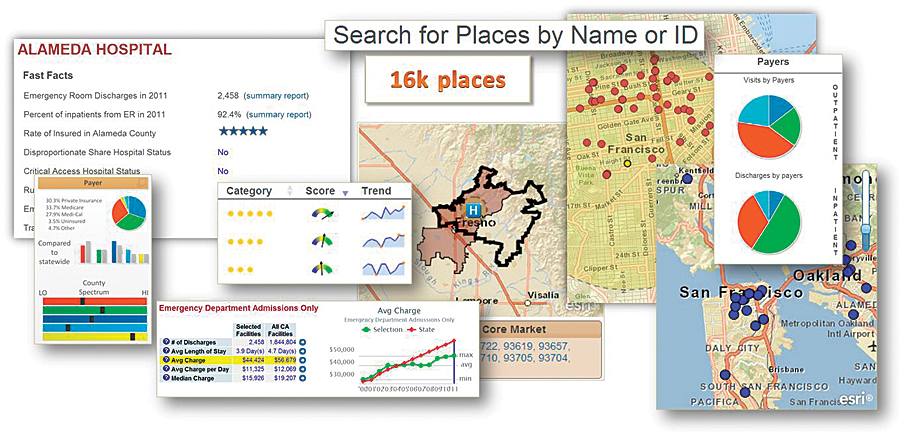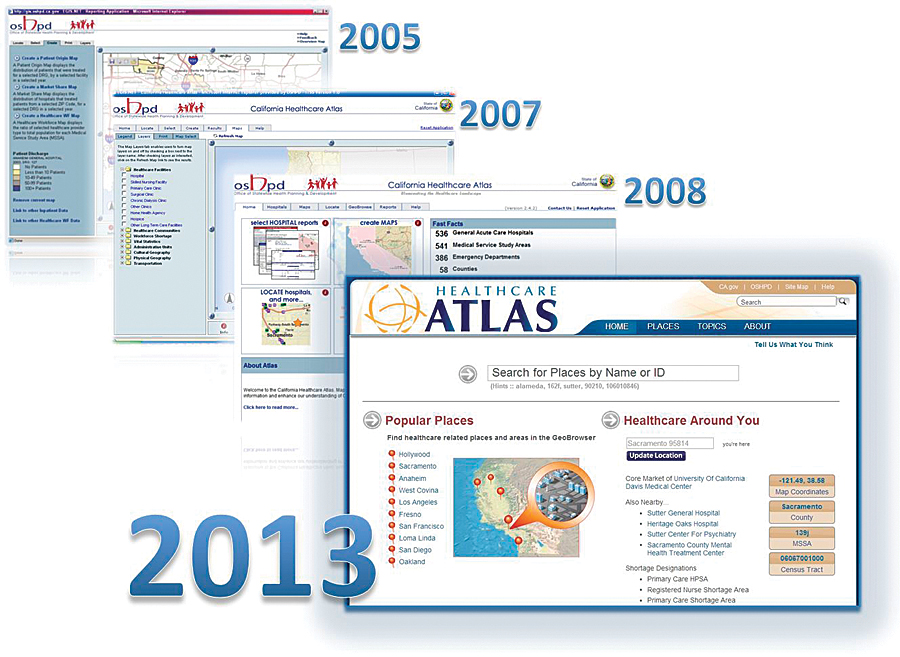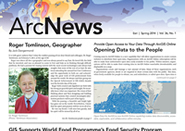Online Exclusive
Californians will require comprehensive information about their local and regional health care delivery systems more than ever as a result of health care reform.
Fortunately, the Office of Statewide Health Planning and Development (OSHPD) has a powerful new tool for making the content of data more transparent: the highly interactive California Healthcare Atlas.

This interactive, Internet GIS mapping application provides users with a large and growing data warehouse and geospatial database containing detailed information on licensing, finances, and utilization of hospitals and health care facilities, as well as annual patient summary reports. Michael O’Neill, OSHPD’s senior geospatial architect, describes this web-based query system, which offers a variety of health care-related maps courtesy of Esri GIS technology.
“This website presents and integrates OSHPD patient, financial, facility, licensing, health professions work force, inpatient discharge, and geographic data into one easy-to-use, open-data portal,” said O’Neill.
The newest version of the atlas offers a more powerful experience, beckoning users to dig deeper than ever before by utilizing the interactive mapping of these data summaries, O’Neill said. Whether you’re curious about the location of nearby hospitals and clinics or are a health profession graduate seeking job opportunities in underserved areas, the atlas provides an array of wide-ranging information and analyses via its dynamic charts, graphs, and responsive maps courtesy of Esri GIS technology, he explained.
The site logically organizes and cross-references more than 16,000 geographic places in California with a myriad of health care facts (from a long list of state and federal sources) into a cohesive, user-friendly, searchable, and cross-referenced atlas of health care information. For example, users can “geobrowse” hospitals in any part of California, then learn a wide variety of facts about those facilities such as financials, special designations, number of beds, common surgery costs, service utilizations, and payer reimbursement rates (see sidebar on page 15).
“California is the only state in the nation to host such a collection of geographic and health care data that is fully searchable, cross-referenced, indexed, discoverable, and yet still user-friendly,” said O’Neill. “We have been wrestling with how to connect more people to our data for years and think we’ve had a breakthrough with this latest version of our atlas product. Nobody has a platform like this.”
According to O’Neill, the atlas serves a diverse set of users. In its pre-atlas days, OSHPD produced data and data products mainly for policy makers, researchers, and facility administrators. They continue to be core consumers of OSHPD-based data.
“But what the atlas does so elegantly is connect a wealth of once-disparate data and then make those relationships easily found and understood,” he said. “This makes current data users happier and new data consumers feel well served.”
“Previously, you would have had to find multiple files or systems and then synthesize the data to get the complete picture or to get answers,” O’Neill recalled. By contrast, with today’s atlas, the data compilation and cross-referencing has been done and then published in OSHPD’s search engine-optimized platform so that information now might be one Internet search away.
“We’ve not perfected the atlas by any means. That would take resources we simply don’t have today,” said O’Neill. “But what we have done so far is to open data silos—wrapped in an inviting package—thus allowing many more would-be information consumers access to authoritative content.”
Users Find Atlas Data Valuable
Alfio Levy, senior associate at Alameda Health System, observed that the hospital market content is proving valuable for growth planning as health care reform continues to unfold. The inpatient-based market maps are “critical for evaluating our growth strategies and have enabled us to have more informed conversations with potential affiliate and partner organizations,” Levy said. “The tool has been very thoughtfully developed; it saves us money and time.”
Alameda’s marketing, communications, and strategy teams are frequent users. Many other visitors to the site come looking for information about areas having one or more of the seven work force shortage designations administered by OSHPD. For example, the Health Professions Education Foundation (HPEF) is awarding $32 million this fiscal year to attract or retain health care professionals in areas of unmet need. Using the atlas, individuals can quickly and easily research where these special designations exist and then learn about the hospitals and clinics located within them.
“The workload burden on staff, grant applicants, and awardees was, in the past, unnecessarily cumbersome,” said Charlene Almazan, lead program officer for HPEF.
Almazan said the website makes their work much easier and quicker: “I love telling our grant applicants and awardees to use my GIS.” There’s lots of money to award, and every efficiency gain ultimately improves health care for someone, she said.
Arsenio Mataka, assistant secretary at California Environmental Protection Agency, contends that “having geographic and demographic information about areas in California lacking sufficient health care professionals provides executives and other decision makers with meaningful insights as they move to improve the health and economic vitality of our state’s most impacted communities.”
“It’s such a simple thing—connecting the geographic dots—and yet the simplicity belies an essential step in connecting people needing services with enough health professionals to provide those services,” O’Neill said.
Background and Evolution of the Atlas
Over 12 years ago, OSHPD acknowledged its difficult task and envisioned information technology solutions to address the challenges, which were formidable, recalled O’Neill. Health care in California is a complex landscape of practitioners, hospitals, clinics, patients, businesses, insurance, diagnoses, treatments, research, and more. In practice, the data reflects that landscape’s complexity. Using, managing, and planning health care are neither simple nor easy for anyone. High on any list of challenges has to be information access and transparency.
“We didn’t call it ‘open data’ 12 years ago,” O’Neill said. “That buzzword hadn’t yet hit the mainstream of popular culture.”
Nonetheless, in many ways, OSHPD faced an open data challenge—with virtual mountains of ethereal bits and bytes stacking up within its walls. The challenge back then—and still today—has been to harness the many unwieldy data silos so that they churn raw data into information in a tangible, inviting way, he said.
Michael Kassis, former CIO and deputy director at OSHPD, remembers that from the late 1990s to 2000, a small number of OSHPD staff members knew how to use GIS in the common desktop workstation environment. Maps were made. Data was processed. Information was created.

“It was business as usual throughout countless organizations,” said Kassis. “If you had the skills, software, data, time, and knowledge to put it all together, you could turn mere data into information.” Both staff and management recognized the value GIS technology brought to the table with its powerful visualizations and geographic analysis. Nonetheless, there were problems:
- Too much data—period
- Too complex and nuanced data
- Too few staff members with sufficient GIS knowledge and skills
- Too many data silos
- Too difficult to find data
- Too difficult to combine disparate datasets
- Too limited publication media
“Having recognized the value in GIS and openly acknowledged the issues, management moved starting in 2000 on multiple fronts to deal with challenges such as insufficient funding and resources,” O’Neill said. A feasibility study report (FSR) made the case for funding a new enterprise-level GIS program and a large, complex data warehouse. By 2004, the programs were funded, contracts were executed, and OSHPD had the beginnings of an enterprise GIS and data warehouse.
“That big step was difficult and yet essential to having the atlas today,” he said.
Technology Today
According to O’Neill, Esri has been a vital technology and solutions partner of OSHPD from the start. The first incarnation (2004) of the website, which proudly focused on its map, published a smaller range of data and debuted as OSHPD’s initial public offering of online mapping combined with data from the new patient data warehouse. The atlas hit the ground running with a cutting-edge web query system—California’s first-ever interactive mapping of health care data.
That was then. Today, the atlas runs ArcGIS Server 10, ArcGIS API for JavaScript, Microsoft ASP.NET MVC, and SQL Server, combined with a few other programming libraries.
“Esri provides us with a comprehensive suite of GIS software,” O’Neill said. “We blend in a variety of small and large technology products, but we are an Esri shop for our geospatial solutions.”
The OSHPD GIS team authors and maintains its geographic datasets for the atlas with the same software used for regular cartographic production, which allows users to publish map services easily on ArcGIS Server. From a staffing and resource perspective, O’Neill and his colleagues find this setup ideal because it allows them to efficiently pair tasks with staff skills.
“GIS tasks are assigned to GIS professionals, and website development is accomplished by programmers,” he said. “Managing the geographic datasets is actually a huge and complex undertaking made easier with Esri tools.”
Some of the “secret sauce” found in the atlas flows from a cookbook-like library of over 100 custom ModelBuilder models. Said O’Neill, “We estimate there are probably 1,800 or more processing steps in all of those models. Without that essential automation using Esri tools, we could not ever keep up with the data maintenance.”
Latest Phase
Having several years of experience and user feedback under its belt, OSHPD realized that things had to change to keep up with quickly evolving expectations for the user experience. The new third-generation version of the California Healthcare Atlas modernizes the platform on which it runs, improves usability, increases data transparency, and adds new data.
“The site’s layout is reorganized to better hold the huge and diverse content presented now and to allow for adding new content going forward,” O’Neill said. “Everything relates to something and, oftentimes, to many things at once. This reflects reality and real geography, where hospitals, people, and administrative boundaries are interconnected.”
The threads or pathways through the site’s more than 16,000 pages are almost limitless. It’s a formidable mountain of data made tangible by attractive interfaces, search engines, search boxes, logical information architecture, and gobs of cross-referencing.
“This generation of the website marks a new beginning for information transparency, site usability, and content discovery offerings by OSHPD,” he said.
Looking forward over the next one to three years, O’Neill anticipates the addition of new health care quality measures, expanding on the hospital market content, and providing more ways for people and systems to consume the data.
“We will continue to improve on our report-like managed content and also improve on freeing the data in new ways to put the power of information into peoples’ hands,” he said.
For more information, contact Michael O’Neill, senior geospatial architect, GISP, California Office of Statewide Health Planning and Development, or call 916-326-3982.

